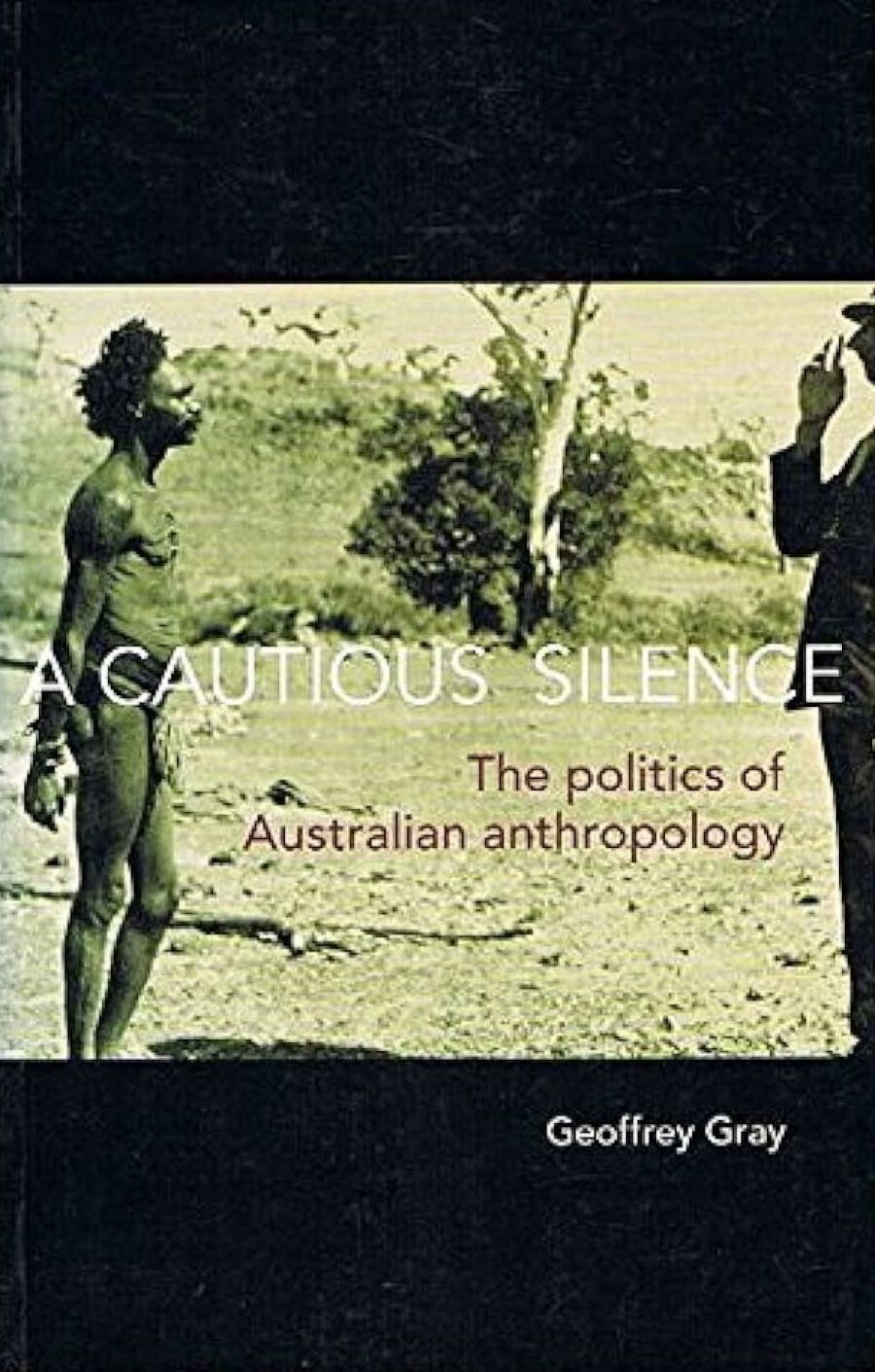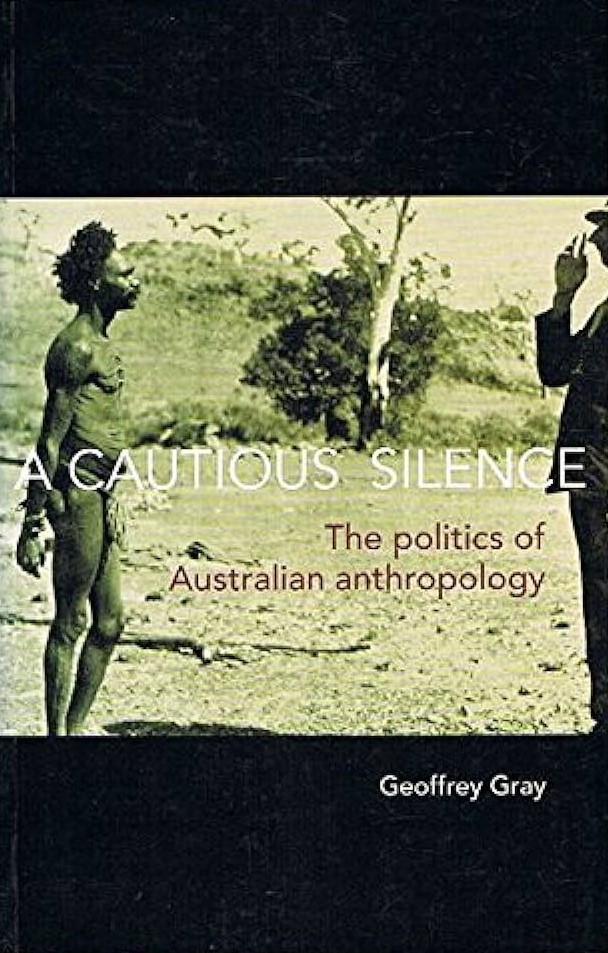
- Free Article: No
- Contents Category: Anthropology
- Review Article: Yes
- Article Title: Forging a discipline
- Online Only: No
- Custom Highlight Text:
A Cautious Silence is about the establishment of anthropology as an academic and applied discipline in Australia from about 1920 until after World War II. During this period, anthropological research in Australia largely focused on indigenous Australia, New Guinea, Papua and some Pacific islands. A signal event marking the beginning of the period covered in the book was the foundation in 1921 of the Australian (rather than British) National Research Council (ANRC). Marking the end were the debates over the establishment of the Woomera Rocket Range and the consequences for Aborigines in the region. Geoffrey Gray’s afterword deals briefly with university and research politics in the 1950s and 1960s.
- Book 1 Title: A Cautious Silence
- Book 1 Subtitle: The politics of Australian anthropology
- Book 1 Biblio: Aboriginal Studies Press, $39.95 pb, 293 pp
- Book 1 Cover Small (400 x 600):

- Book 1 Cover (800 x 1200):

The book pays some attention to different kinds of institutions and interests involved in the academic and applied practices of anthropology: funding bodies (such as the ANRC); university anthropology departments (mainly the University of Sydney, Australian National University and the University of Western Australia, with less said about Adelaide and Melbourne, not yet constituted as departments); churches, missions, boards with responsibility for Aborigines (such as Vestey’s, the pastoral company); and museums. There is discussion of the relations among university departments and branches of government around the question of training in anthropology for officials working with Aborigines and other ‘native’ peoples.
A Cautious Silence does not aspire to be a comprehensive history of any of this. It does claim to be ‘the first exploration of modern Australian social anthropology’ and the forces that shaped its formation. The author describes the book as being ‘built on a thorough investigation of the work and lives of individual anthropologists’ who worked for the ANRC and the University of Sydney – most of them Australianists, or viewed mainly in their capacity as such. Besides treating anthropologists in their roles in the establishment of the discipline (Alfred Radcliffe-Brown, Raymond Firth, Ian Hogbin, A.P. Elkin and others), the examination of the work of a number of anthropologists and others as field researchers is indeed at the book’s centre: these include Radcliffe-Brown, Elkin, Reo Fortune, Ralph Piddington, Phyllis Kaberry, Donald Thomson, Ursula McConnel, W. Lloyd Warner, C.W.M. Hart, Olive Pink, W.E.H. Stanner, and Ronald and Catherine Berndt. A final section focuses on anthropologists’ involvement during the war, as well as that of Aborigines, and competing views of anthropologists, government officials and others about their future.
Thus, the main focus of this book are anthropologists (and other field researchers) and their relations with Aborigines, government and academia. The author is principally interested in the ways that anthropology became institutionalised as the authoritative study of colonised peoples, and anthropological practice and knowledge came to be seen by colonial administrators, and recommended by creators of the discipline of anthropology, as relevant to managing the people under their charge. Mainly, he is interested in the views that anthropologists themselves took of the situations of the ‘native peoples’ they worked with, the extent to which they remarked upon and publicised their often lamentable or oppressive conditions, and attempted to act to improve them – or did not.
Anthropologists are shown not to be vastly different in their social orientations from other relatively educated and liberal people of the time. A certain conservatism is also notable. A number of shared understandings and concerns that underpinned relations between anthropologists and government can be identified in the book. First, particularly at the beginning of this period, there was a view that Aborigines were dying out. For administrators, the implication might be that better or different management was required; for anthropologists (among others), this meant that it was important to record what was ‘left’ of traditional culture before it was too late. Second, a prevailing scientism pervaded both anthropology and colonial management, and often seems to have been stronger than humane recognition of the conditions under which the colonised were living. Third, there was a widely held, though not universal, view that anthropology might ‘provide invaluable service’ in colonial affairs. Clearly, it was useful to early anthropologists to assert this, and it was often useful to administrators to claim that there was a relevant scientific practice on which they could draw.
Fourthly, there was the question as to how anthropologists would behave in the field. Would they be disruptive to officialdom, or cause trouble for authorities charged with responsibilities for indigenous people? Often enough, this was posed as an explicit issue in negotiations over anthropologists’ access to field locations, missions and settlements. Anthropologists were often not welcomed by administrators, on the assumption they might cause trouble. A few, like Piddington, made themselves personae non gratae by writing about the abusive treatment of Aborigines; others, like Pink, who were closely involved with Aborigines on a daily basis, were widely seen as eccentric do-gooders. Academic facilitators and supervisors such as Elkin often had to reassure gatekeepers that field researchers had ‘common sense’ and would not cause trouble. In practice, this may have implied that they were refraining from negative comment about conditions.
Finally, it was widely assumed by both administrators and anthropologists that the best possible hope for native peoples was that of taking an ‘equal place’ in the encapsulating or colonial society – not a distinctive one. That idea was not to make itself felt for some two decades.
It is in view of themes such as these that Gray characterises the response of anthropologists to the situation in which they found themselves as a ‘cautious silence’. This generalisation opens up interesting possibilities, but unfortunately is not developed fully. Under today’s somewhat changed circumstances, some of the same questions concerning the relation between anthropology as a critical and field discipline, and its orientation to the world and the people whose lives anthropologists study, continue to be highly relevant. There are interesting questions of institutionalisation, intellectual styles, discipline-building, intergenerational academic relations, and the roles of anthropologists as members of the developing profession, and of their home societies, all of which could be considered in a more structured and analytical way than this book does.
But in order to do that, the author would need to be able to offer a more robust analysis of institutions and the lives of persons in relation to them, and a more clearly articulated set of research questions. The most clearly set out is the proposal of the ‘cautious silence’. But while this is presented as a characterisation of the culture of anthropologists in the book’s introduction, it is not adequately discussed thereafter.
The core of the book remains the depictions of anthropologists. Some of the contextualising material is not presented systematically. Gray seems to be writing principally for an audience already familiar with this history in Australia. Insufficient attention is paid to drawing in and addressing a wider (and potentially international) audience.
Not much in the book is new, possibly because there have been other books on some of the individuals whom Gray discusses, and many articles (including some of his own) that cover much of this ground. But Gray has done a service in bringing these stories together in one place.
Two final notes on the author’s positioning of his material. The first relates to Gray’s opening observation that anthropology’s past may be said to be founded on anecdote, gossip and myth. There are of course more public and more private, closed-circuit versions of the past of particular professional groups, both established and in the making. Gray’s material is to some extent a mixture of these versions. But of what discipline could it be said that anecdote, gossip and myth are not formative? (Examples that suggest their general relevance are Traweek’s 1988 account of the culture of high energy particle physicists, and Newmeyer’s 1986 account of the polarised and fractious field of modern linguistics and its practitioners.) But second, and relatedly, the book’s epigraph is a quote from the anthropologist David McKnight: ‘Australian anthropology from the very beginning has been marred by quite exceptional ill will, bitterness, and personal vendettas.’ This point, and the subtitle’s reference to ‘politics’, required more explicit theorisation if they were not to be viewed as pure spleen – maybe McKnight’s. If anthropology was marred by ‘exceptional’ ill will, why was this? What was at play, and what at stake? I would not want an answer at merely the level of interpersonal politics, but at other levels too.
The book required closer editing, and the Aboriginal Studies Press might take note. Infelicitous or inappropriate uses of words are found in a number of places (e.g. ‘nadir’, when ‘zenith’ is meant, ‘ingeniously’ instead of ‘ingenuously’). In addition to occasional typos, some prepositions and references are missing.
The subject matter of the book remains important and deserves expanded critical analysis. This book should be read by anyone interested in extending such analysis.


Comments powered by CComment